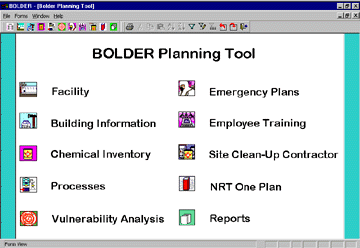Opening Image and Table of Contents of the
B.O.L.D.E.R. Planning Tool CD-Rom
BR>

The B.O.L.D.E.R. Planning Tool:
|
Opening Image and Table of Contents of the
B.O.L.D.E.R. Planning Tool CD-Rom
BR>
|
The B.O.L.D.E.R. Planning Tool: |
SIMPLIFIES
There are nine separate federal emergency response programs, with 526 pages of complex, redundant, and confusing regulations. A facility could have up to nine separate and confusing plans, or it could have just one easy one. The B.O.L.D.E.R. Planning Tool has condensed these nine emergency response plans into just 27 pages of simple clear, and easy to understand requirements in a software tool.*
ACHIEVES COMPLIANCE
When a facility uses the BOLDER software and submits the facility emergency plan, it fulfills all these nine federal regulatory mandates. Once the data is submitted, the B.O.L.D.E.R. Planning Tool files all of the required reports with all the points of compliance. The B.O.L.D.E.R. Planning Tool software is the model for an electronically integrated emergency response planning program for the entire country.
IS MORE REALISTIC, MORE USEFUL
Facility owners and operators often confide that they don't actually use the several emergency plans they have had to prepare; they use a scaled down version. The B.O.L.D.E.R. Planning Tool software allows for a computerized (or hard copy) version of the REAL facility emergency plan.
PROVIDES REAL-TIME UPDATED FACILITY INFORMATION
If the facility makes physical changes, relocates chemical storage, changes processes, changes chemicals, this real-time information can be quickly updated and forwarded electronically to achieve compliance.
PROVIDES BETTER FACILITY INFORMATION
The B.O.L.D.E.R. Planning Tool actually asked firefighters and other emergency responders, regulators, facilities, and community stakeholders what they REALLY needed for effective emergency response. The B.O.L.D.E.R. Planning Tool software allows a facility to provide much more specific and detailed information, such as floor plans, roof plans, access hatches, chemical storage areas, shut-offs, fire walls, computerized chemical inventories and MSDS inventories. Even digital pictures of the facility can be put into the facility information. This information allows responders to most efficiently handle any facility contingency. The more efficient and timely the response, the more liability is minimized, and the less risk to firefighters, facility emergency teams and employees.
IS BETTER FOR COMMUNITIES AND COMMUNITY GROUPS
Community stakeholders in the B.O.L.D.E.R. Planning Tool have emphasized that the most important things to them is to know that facilities are in compliance with their emergency response plans, and that the emergency planning and response system has this facility emergency response information on hand and in a way that can be easily accessed and used. This information includes vulnerable areas that may need evacuation or shelter-in-place. It is in a community's best interest that the B.O.L.D.E.R. Planning Tool is implemented in the community, as its use inherently reduces hazards and risks from chemical spills and incidents by providing informed and efficient response and preparedness.
IS BETTER FOR FIREFIGHTERS AND EMERGENCY RESPONDERS
Facility emergency response information, even when filed with the appropriate entities, is currently not available at the scene of an incident. The B.O.L.D.E.R. Planning Tool puts special laptop computers into the hands of onscene coordinators so they can access the facility's emergency response information. In terms of responding to a chemical spill, imagine the difference between wondering what chemicals are inside a darkened building and looking at a digital picture or detailed facility site plan!
IS BETTER FOR FACILITIES
What was once a confusing, paper and time-intensive task becomes something imminently manageable. Once the facility information has been entered into the computer using the B.O.L.D.E.R. Planning Tool software, updates and changes take just minutes.
IS BETTER FOR EMERGENCY PLANNERS
Everything is available electronically, saving storage space and the expenses of filing and tracking mountains of redundant paperwork. Scant government resources can be devoted more to actual emergency planning and preparedness instead of clerical work.
*61 FR 28642, June 1996, is the Federal Register notice for the One Plan Guidance. In this, the Environmental Protection Agency, the Department of Labor, the Department of the Interior, and the Department of Transportation jointly issued a guidance on drafting an integrated contingency plan.
For more information about the National Response Team's Integrated Contingency Plan Guidance (One Plan), review the document at: http://www.epa.gov/swercepp/pubs/one-plan.html